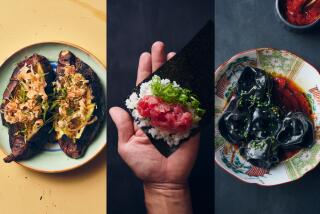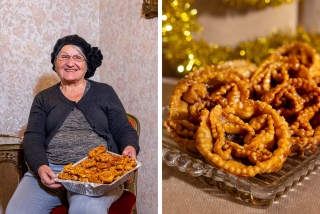Italian Food. With Love
COLVALENZA, Italy — For Donaldo and Dino Soviero, this is a dream come true.
The New York-born father and son, both professional chefs and cooking instructors, have opened La Scuola de Cucina Italiana, an Italian cooking school and restaurant in the green hills of Umbria, 90 miles north of Rome.
And they’ve made a deal to market their homemade tomato sauce to a chain of Italian restaurants under the trademark, “La Vera Cucina Italiana”--”true Italian cooking.”
“My son and I both very much like Italian cooking, not just that we’re Italian chefs. But really and truthfully, we eat Italian every day: breakfast, lunch and dinner,” says the silver-haired Donaldo.
‘Experience the Food’
“It’s a deep love affair. Having taught Italian cooking and having opened Italian restaurants over the years, we just felt that it’s time to live here and actually experience the food.”
A lawyer as well as chef, Donaldo has owned, operated or been associated with more than two dozen resorts, hotels, clubs and restaurants in the United States, including Max’s Kansas City in New York and the Music Inn and Bousquet Ski Area in Massachusetts, where he pioneered the use of artificial snow.
As part of a varied career, he headed the New York agency that handled entertainers such as Ike and Tina Turner, B. B. King and Ray Charles. He also has taught Italian cooking in the United States (from his home in Bel-Air), Mexico and Spain, and was director of the hotel and restaurant school at New Mexico Highlands University.
Dino Soviero, a 32-year-old look-alike for actor John Travolta, is a wine expert who has cooked professionally since his teens and taught at the Culinary School of Washington, D.C.
They hope their experience as teachers, as well as their expertise as chefs, will set their cooking school, whose first full season of classes opened in June, apart from all the rest.
“Not all great chefs make good teachers,” Donaldo says. “But if you combine the two, you should have something special.”
Farmhouse to Kitchen
To this end the Sovieros bought a 300-year-old stone farmhouse on a dirt road near the picturesque town of Todi and spent nearly two years transforming it into a dream kitchen of their own design.
“Most cooking schools I’ve visited are not built particularly as schools,” Donaldo says. “They are either a chef with a restaurant kitchen, where he lets people into the kitchen and they have to work around his normal set-up, or they’re in somebody’s home; they may put in a special stove or something, but by no means is it a complete facility.”
The Sovieros designed their work space to include five professional ranges with 22 burners and four ovens, two wood-burning ovens, a separate pasticceria for pastry and bread making, outdoor and indoor grills and rotisseries and big marble-topped or butcher-block work tables.
All is set within a spacious rustic hall, like a mammoth farmhouse with wood-beamed ceiling, terra cotta tile floor and picture windows that look out on a spectacular view of Todi amid the Umbrian hills.
Plants hang against the stone walls, copper-bottomed cookware gleams from overhead racks, there’s a conversation pit area around an open hearth and one end of the room forms a dining area big enough for a banquet.
Adequate Work Space
By limiting class size to 12, Donaldo believes each student will be able to have space to work and get adequate attention during the class.
“Everything is portable,” Donaldo says. “The tables move around, so do some of the stoves.”
Classes will be a blend of formal, in-depth lectures, demonstrations, practical application and eating. Course schedules warn students not to eat much breakfast.
Main class sessions, so far planned for five months of the year in spring and fall, will last a week in a $1,695 package that includes six nights in a first-class hotel in Todi, five days of lessons, plus field trips to markets, wineries, cheese and sausage producers and restaurants. In season there are visits to olive presses and truffle hunts.
Each student will receive a 500-page course book written by the Sovieros, including sections on the history and cultural background of Italian cuisine, the different cooking styles in Italian regions, specific topics such as pasta, sauces, meat and fish, and recipes for all dishes taught.
Picking Vegetables
Each day of the course will be devoted to a different region and a different topic, and will begin with a visit to the school’s garden to pick the salad greens, herbs and vegetables for that day’s demonstrations and eating. Students will also taste a variety of olive oils, vinegars and spices.
For example, on Monday it’s pasta, pasta, pasta. The lecture will be all about pasta, the demonstrations will make several kinds of pasta--spinach noodles, regular noodles--and then eight or 10 sauces for the pastas. They’ll then have an assaggio, or little bits and tastes of these pastas, with these different sauces, to understand the flexibility of Italian cuisine at its basic level.
“You start with a garlic and oil sauce-- aglio-olio,” Donaldo says, “then immediately go into 30 or 40 expandables. Then we’ll make three or four of the expandables, so that they can get an idea of what happens, so they can see how an aglio-olio becomes these other dishes.
“They sit down after all this pasta work to a formal lunch, which we pride ourselves is as good as they can get in any restaurant in Italy, if not better. At the same time, there’s a lecture on the day’s region, and there are six to eight wines of the region to taste,” Donaldo adds.
In addition to the weeklong course, the Sovieros plan year-round one-, two- and four-day workshops on specific topics. For example, a daylong workshop specializing only in breads and pizzas, or one on pastas, combined with a second day concentrating on meats.
Two days of lectures, demonstrations, participation lessons, wine and oil tastings and formal dinners, including hotel, meals and local transportation costs 385,000 lire (about $296 U.S.). A one-day bread-and-pizza workshop, combined with lunch and a Chianti tasting, costs 50,000 lire (about $38.50 U.S.).
Special Dining Groups
In addition to the school, the Sovieros also offer reservation-only restaurant dining for groups of eight or more. For a set fee per person of 75,000 to 150,000 lire ($58 to $115), depending on what wines are served, Donaldo and Dino will prepare and serve gala dinners according to menus drawn up in consultation with the clients.
A recent run-through dinner similar to the menus he will serve at the restaurant started with cheese fritters and tiny fried smelts served with homemade bread and pizza. Then it went on to a salad of celery, cheese, radish and mushrooms; zuppa di pesce (fish stew); linguine con gamberi Fra Diavolo (linguine with spicy shrimp sauce; lemon sorbet; anatra all’arancia (duck in orange sauce); creamed spinach and chard; potatoes rissole, fruit and cheese; walnut torte; coffee and assorted liqueurs.
Different fine wines and spumante accompanied each course. Guests were invited to watch the cooking process and learn how each dish was prepared.
Donaldo noted that businessmen in Todi have invested in the operation, and that friends and business contacts to whom he had given jars of his tomato sauce as gifts, liked the sauce so much that they decided to form a company and market it in Italy. Result: “We have a contract for 5,000 jars initially from RistorAgip,” which runs restaurants at autostrada rest stops, Donaldo said.
Then he gets up and heads for the kitchen. Talking about food has made him and his interviewer hungry.
“What do you say to a little lunch?” he asks.
For more information, write to the La Scuola di Cucina Italiana in Umbria, Casella Postale 127, 06059 Todi (PG), Italy.
More to Read
Eat your way across L.A.
Get our weekly Tasting Notes newsletter for reviews, news and more.
You may occasionally receive promotional content from the Los Angeles Times.










